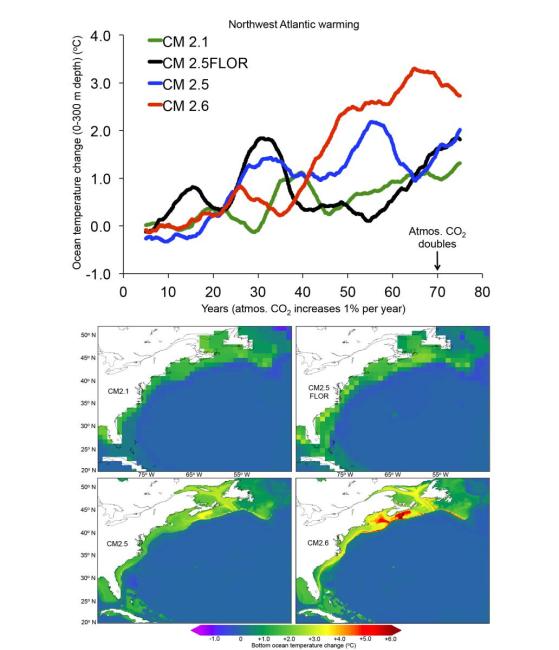Enhanced warming of the Northwest Atlantic Ocean under climate change
The Intergovernmental Panel on Climate Change (IPCC) fifth assessment of projected global and regional ocean temperature change is based on global climate models that have coarse (~100-km) ocean and atmosphere resolutions. In the Northwest Atlantic, the ensemble of global climate models has a warm bias in sea surface temperature due to a misrepresentation of the Gulf Stream position; thus, existing climate change projections are based on unrealistic regional ocean circulation.

In a new paper by Saba et al., they compare simulations and an atmospheric CO2 doubling response from four NOAA Geophysical Fluid Dynamics Laboratory (GFDL) global climate models of varying ocean and atmosphere resolution. They find that the highest resolution climate model CM2.6 (~10-km ocean, ~50-km atmosphere) resolves Northwest Atlantic circulation and water mass distribution most accurately. The CO2 doubling response from CM2.6, over 70-80 years, shows that upper-ocean (0-300 m) temperature in the Northwest Atlantic Shelf warms at a rate nearly twice as fast as the coarser models and nearly three times faster than the global average.
This enhanced warming is accompanied by an increase in salinity due to a change in water mass distribution that is related to a retreat of the Labrador Current and a northerly shift of the Gulf Stream. Both observations and the climate model demonstrate a robust relationship between a weakening Atlantic Meridional Overturning Circulation (AMOC) and an increase in the proportion of Warm-Temperate Slope Water entering the Northwest Atlantic Shelf. Therefore, prior climate change projections for the Northwest Atlantic may be far too conservative. These results point to the need to improve simulations of basin and regional-scale ocean circulation.
Over the past 10 years, the Gulf of Maine has warmed at a rate faster than 99% of the global ocean. The enhanced warming of the Gulf of Maine is associated with a northerly shift in the Gulf Stream, which is similar to the results reported here for GFDL’s CM2.6. Contemporary changes in the distribution and species composition of Northwest Atlantic living marine resources are already evident, but existing projections are based on warming scenarios from coarse resolution models. Warming on the scale of 3 to 4 oC, as shown in GFDL’s high-resolution climate model, will cause more extreme effects on the ecosystem.
Enhanced warming on the Northwest Atlantic Ocean under climate change (Journal of Geophysical Research-Oceans)
1National Oceanic and Atmospheric Administration, National Marine Fisheries Service, Northwest Fisheries Science Center
2National Oceanic and Atmospheric Administration, Geophysical Fluid Dynamics Laboratory
3National Oceanic and Atmospheric Administration, Earth System Research Laboratory
4National Oceanic and Atmospheric Administration, National Marine Fisheries Service
Topics
- Atlantic Ocean
- Climate Change
- AMOC
- Ecosystem Impacts
